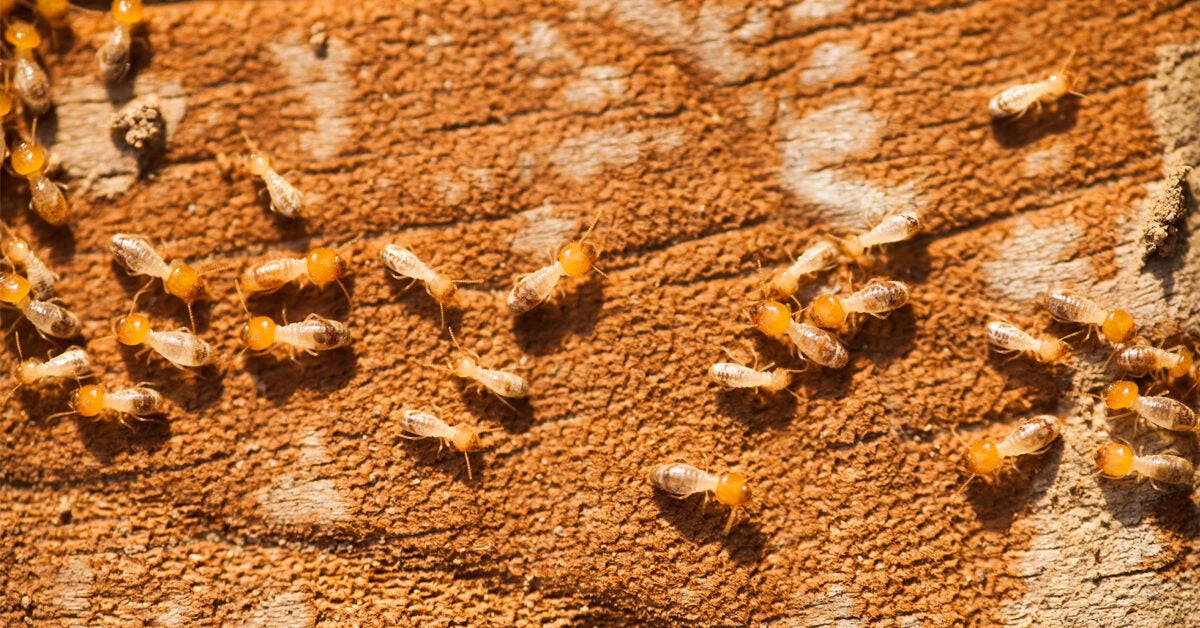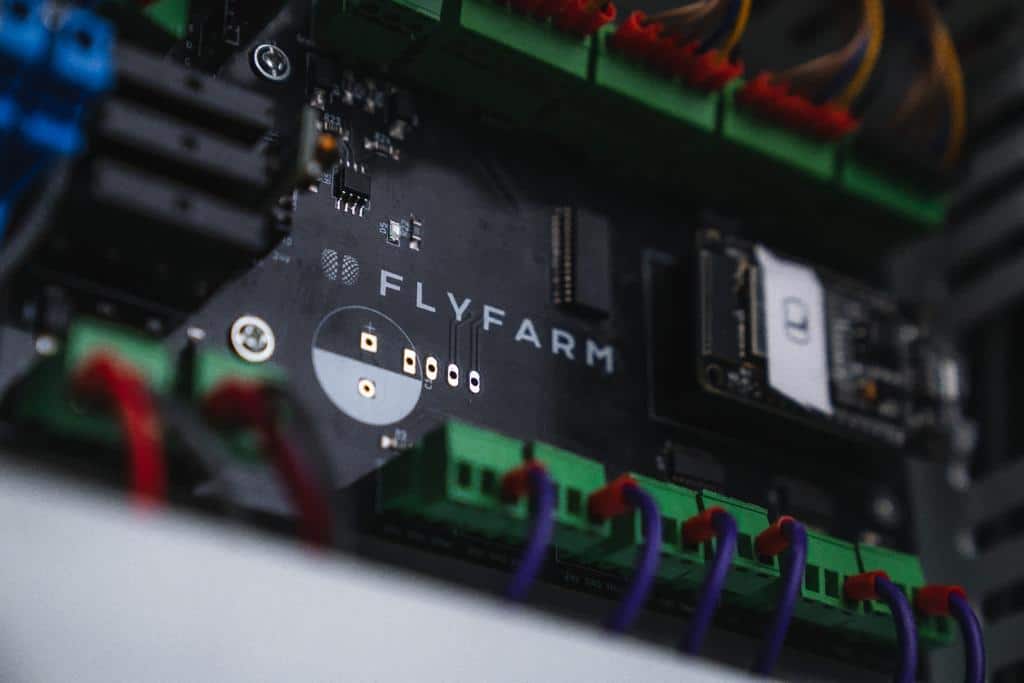To get her dragonflies to hunt as they might in the wild, neuroethologist Paloma Gonzalez-Bellido had to simulate Florida inside her lab at the University of Minnesota, where the average outside winter temperature sits well below freezing. The ceiling of her custom-built arena—itself an entire room—is lined with LEDs to mimic the warm tones of a cloudy day, and a climate control system keeps the space hot and humid. Stepping inside, Gonzalez-Bellido removes the lid on a container of Drosophila, and the dragonflies stiffen on their perches at the sight of their lunch.
What typically follow are remarkably efficient, airborne strikes, where predators are virtually assured of capturing their prey. Dragonflies have a 95 percent catch rate, and their four wings drive an impressive repertoire of aerial maneuvers, including backwards flight. To understand the mechanics of those behaviors, Gonzalez-Bellido needs to be able to study the animals unrestrained. Using high-speed cameras to film insects housed in the arena, she has documented the flight behaviors not just of dragonflies, but of robber flies, killer flies, and damselflies as well. Each, she says, has followed a unique path to success. “Insects have been evolving to survive, and they’ve done it remarkably well.”
The desire to understand insect flight goes beyond Gonzalez-Bellido and across disciplines, drawing researchers from fields such as neuroscience, ecology, physics, and meteorology. In addition to questions of evolutionary innovation, there are practical applications that could grow from a more robust mechanistic appreciation of insect flight. Engineers have already created insect-inspired aircrafts and drones, and some researchers are working toward creating biomimetic flying robots to track the smoke from forest fires, identify invisible gas leaks, or search for survivors following natural disasters. The challenge is that most insects are too small to carry trackers, and their size and speed makes them difficult to follow with cameras, typically forcing researchers interested in probing the neural basis or kinematics of flight to restrain their insects.
If you think about the Holodeck from Star Trek, you’re not too far off.
—Andrew Straw, University of Freiburg
Now, Gonzalez-Bellido and others are getting creative to observe the animals as they fly freely. From custom-built arenas, sometimes complete with virtual reality effects, to an apparatus that flies around with the insect being studied, the approaches are aimed at recreating and recording natural flight. As researchers with different backgrounds continue to enter the field, they are bringing with them novel approaches and tools—video gaming technology, robotics, radar, and even missile guidance systems—to more holistically detail how insects have mastered the skies.
An immersive experience
Insects were the first animals to take to the air, refining the structures and behaviors that power their flight over 350 million years. In that time, they have adapted to respond quickly to ever-changing environmental conditions and react to unexpected obstacles at a moment’s notice. Some species are able to capture prey in the blink of an eye, while others can track invisible odor plumes for kilometers. Several insect groups, including some ants, termites, and bees, among others, have even evolved to mate completely on the wing.
Much of what is known about insect flight—how the animals navigate, evade danger, and integrate sensory information—stems from experiments in which the insect under study is restricted, either by tethering it with a thread or wire, gluing it to a pin, or isolating it in a wind tunnel. As a result, the findings of these early experiments come with a large caveat, says Shannon Olsson, a chemical ecologist at the Tata Institute of Fundamental Research in India. “If you take away entire dimensions by restricting them, that will of course induce a lot of artifacts.”
An arena is one way scientists are trying to prompt more natural insect behavior in the lab. Gonzalez-Bellido’s dragonflies, for example, will hunt only if the room’s climate is just right. But some species require a more visually complex environment to behave as they might in the wild. Enter virtual reality (VR).
Pulling heavily from video game technology, University of Freiburg neuroscientist Andrew Straw has spent years developing a virtual reality arena called FreemoVR in which animals can move unrestricted. The screens, graphics, and software all combine to create an immersive VR experience that continuously reacts to the insect inside. “If you think about the Holodeck from Star Trek, you’re not too far off,” Straw says.
Straw and his colleagues started with a simple experiment to validate the use of the arena and to determine how a common manipulation used in tethering experiments—gluing a fruit fly’s head to its thorax, which stops it from turning its head—affects an insect’s ability to fly. The researchers programmed the screens to display moving dots that changed speed and direction as the flies approached, prompting them to travel in a figure-eight pattern to avoid colliding with the dots (and therefore the walls) of the arena. Flies that had not been glued navigated around the arena without issue, while the glued individuals were unable to fly properly, showing just how much some manipulations can corrupt an insect’s natural behaviors.
Virtual reality is giving researchers the ability to control what an insect sees as it navigates around an arena.
STRAWLAB.ORG/FREEMOVR
Straw is now using the arena to study how flies react to conditions that are more natural looking, with a goal of understanding how specific populations of neurons influence behaviors. He has also deployed thermogenetics in freely walking—and hopefully one day free-flying, he says—Drosophila, developing a “fly mind-altering device” (FlyMAD) that uses heat to control the activity of specific neurons. While many optogenetic experiments require the insect to be immobilized, Straw says, combining VR with thermogenetics will provide an opportunity to “study more naturalistic behavior in a very rigorous way.”
Moving forward, researchers such as Olsson are also interested in using VR to dissect the natural world in ways that are completely unnatural. Olsson programmed scenarios where trees no longer changed size as a fly moved towards them to determine whether the insects are able to perceive depth. In the future, researchers may also be able to use these experiments to study how individual aspects of perception are integrated by an insect’s brain. “That’s where I think the power of VR actually comes into play . . . to be able to parse reality into its pieces and try to understand those in a way that you can’t do in the real world,” she says.
Virtual Reality Arenas© THOM GRAVES How it works Scientists use digital gaming technology to create realistic environments for animals inside an arena. Pros
Cons
See full infographic: WEB |
Tracking the suckers
Virtual reality arenas bring elements of the natural world into a space that gives researchers control over their work, but even within the confines of those arenas, scientists still need a way to track insects as they fly. In rare cases, an insect may be fitted with a tracker.
Huai-Ti Lin, a scientist and engineer at Imperial College London, has successfully deployed an ultralight backpack capable of measuring the neural activity of flying dragonflies in real time. Tiny electrodes wired to the backpack penetrate into the insect’s nervous system and record neural impulses as it flies. While the results of his experiments have yet to be published, Lin says he plans to use the backpacks to compare the neural firing of free-flying individuals with that of tethered ones and dive deeper into the sensorimotor signal pathways involved in complex behaviors such as predation.

Larger insects such as hawk moths and dragonflies (above) can be fitted with trackers to study their flight. Here, tiny electrodes wired to a backpack penetrate the nervous system of a dragonfly to record its neural impulses in real time.
HUAI-TI LIN
In most cases, insects are simply too small to be tracked the ways that other animals are, and scientists are limited to following the movements of freely flying insects on camera—an approach that takes a little savvy to execute. Gonzalez-Bellido’s custom arena uses four fixed cameras that snap as many as 1,000 frames per second. That speed is critical, she says, because some aerial predation events take only a few hundred milliseconds. The camera speed is a double-edged sword, however. “Even one second generates a huge amount of data,” she tells The Scientist, making it nearly impossible to analyze footage the traditional way, with researchers annotating each frame by hand.
As a consequence, many researchers have started to employ artificial intelligence, including programs such as DeepLabCut that track an animal’s pose and position in three dimensions. This software, and others like it, are first trained on 50 to 200 frames of video that have been annotated by the researcher, who chooses which parts of an animal to track over time. Afterwards, the algorithm can identify and follow an insect’s eyes, wings, legs, or antennae as they move, processing terabytes of data in mere minutes.

Scientists need powerful algorithms to process the massive amounts of data produced by today’s high-speed cameras. Programs such as DeepLabCut can be trained to track parts of an insect’s body through space by analyzing millions of frames individually.
DATA FROM LIN ET AL. 2017, DEEPLABCUT
Camera placement is also essential. To make those decisions, some researchers draw on the behavior of their species to put cameras in the most opportune spots. Hawk moths, for example, hover as they feed on the nectar of flowers, so researchers can easily train a lens at a fake or potted plant. For predatory insects, Gonzalez-Bellido often uses a silver bead threaded onto fishing line to mimic flying prey, allowing her to aim her cameras along the predetermined trajectory that the bead will take.
Better still, says neurobiologist Dominique Martinez of the University of Lorraine in France, would be a camera that moved alongside the animal. To develop that, “we knew we would need a very fast robot with very fine control,” says Martinez, who began brainstorming with his colleagues to make such a device in 2016.
Ultimately, the team members created a tool they call the “lab-on-cables,” a shrunken version of the aerial Spidercam that sweeps smoothly over football stadiums. A large outer frame anchors a series of eight cables and motorized winches that control their length. Inside the frame, held aloft by a cable at each corner, is a small, open cube (30 cm3) in which an insect flies. As the animal moves, the cables contract and loosen to move the cube so the fly remains in its center. Two cameras mounted to the cube detect the insect as it flies, feeding information to sophisticated tracking software that controls the winches, while a single high-speed camera captures images of the insect at 400 frames per second.

Scientists in France used missile guidance and sports stadium technology to design a robot capable of following an insect as it flies. The robot is able to predict where an insect is likely to travel, directing a series of winches that keep the insect centered inside a cube fitted with several cameras.
DOMINIQUE MARTINEZ
Because insects move so unpredictably, keeping a study subject centered in the cube was a challenge, says Martinez. The team borrowed algorithms from missile guidance technology that attempt to predict where an object is likely to travel next. “We try to go a step ahead and . . . move the camera there,” Martinez says.
The team’s initial study validated the lab-on-cables approach using prerecorded flights of fruit flies, mosquitoes, and moths from previous research. The scientists fed the three-dimensional location data into the computers controlling the winches, and every 10 milliseconds, the cube moved to a new target. In more than 90 percent of the cases, the tracking error was less than 1 centimeter, meaning the insect would have easily remained inside the cube. Next, Martinez tested the setup on free-flying cutworm moths (Agrotis ipsilon). Using high-speed cameras, he showed that moths tend to orient their bodies vertically when flying relatively slowly, only leveling out to horizontal as they reach velocities of up to 3 meters per second. The team’s findings confirm earlier reports of this type of flight, described by what’s known as a helicopter model, recorded by researchers studying other moth species.
Martinez says he imagines the lab-on-cables being used in the field. While the frame is large, it can easily be deconstructed and moved outdoors to study insects under more natural conditions. “Wherever you want to work, you just attach the cube to the cables, and you can do your experiment.”
Lab-on-Cables
© THOM GRAVES How it works In a setup that is similar to the cameras used in sports stadiums, a central cube is controlled by a series of winches and cables to move around an insect as it flies. Pros
Cons
See full infographic: WEB |
A meteorological nuisance
Beyond investigations of individual insects, researchers are studying how swarms move en masse using radar. After the technology became popular during World War II as a means of tracking enemy aircraft, many countries built extensive radar networks spanning thousands of miles. Nowadays, they remain useful as tools for forecasting weather and for tracking airborne insects, birds, and bats. While radar signals from insects are typically filtered out of weather data as noise, entomologists in the past decade have begun to recognize that such information can be very informative.
“Meteorologists have been accidentally looking at bugs on radar for decades, and it’s always just been an annoyance,” says Phil Stepanian, a biometeorologist at the University of Notre Dame. But radar “is one of the rare ways that you can actually see large groups of insects up in the airspace.”
Stepanian uses meteorological radar networks to track the synchronized emergence of mayflies (Hexagenia spp.) around Lake Erie and the upper Mississippi River. Each summer, billions of mayfly nymphs surface from their aquatic nurseries as newly grown, winged adults. The ensuing mating frenzy lasts for only a few days, after which every adult dies. In some areas, dead mayflies pile up so high they need to be cleared with snowplows.
Understanding the rhythms of mayfly mating has important ecological implications, says Stepanian, as mayflies are often food for other animals. “As adults they’re bird food . . . [and] while they’re still in their nymph stage in the water, they’re fish food,” he explains, adding that both recreational and commercial fishing in the Great Lakes indirectly depend on mayflies. In addition, their presence is a good indication that aquatic ecosystems are healthy, as mayflies are especially sensitive to water quality.

Radar isn’t just for predicting the weather anymore. Today, entomologists can use radar to track the movements of ecologically and economically important species, such as the annual emergence of billions of mayflies over the Great Lakes.
PHIL STEPANIAN
Using radar data from 2012 to 2019, Stepanian and his colleagues found that adult mayfly abundances in the upper Mississippi River declined by more than 50 percent in that 7-year stretch, and numbers have plummeted in Lake Erie by more than 80 percent since 2015. While the team is still investigating the cause, Stepanian notes that previous die-offs have been attributed to a lack of oxygen in the water caused by industrial and agricultural contamination.
Radar has proven to be such an effective tool for tracking the flight behavior of swarming insect species that entomologists are designing new systems specifically meant to provide greater detail at the level of individual insects. While weather radars use a broad sweep of radio waves to image the skies, entomological radar, as well as another remote sensing tool called LiDAR that relies on lasers rather than radio waves, produce a narrow, vertical beam that relays information about insects as they pass through it. In addition to capturing the size, shape, speed, direction, and orientation of their subjects, some researchers have been able to identify the species, and even sex, of the organisms imaged by these technologies. An international team of researchers, for example, is using LiDAR to track the movements of disease-carrying mosquitoes in southeastern Tanzania. Only female mosquitoes transmit disease, and LiDAR can distinguish between the sexes based on their wing beat frequencies. The group found that the insects were most active during morning and evening “rush hour” periods, giving local officials an ideal window to treat the area with sprays designed to prevent the spread of malaria.
Alistair Drake, a retired radar entomologist at the University of New South Wales in Australia, is also using specially designed entomological radars to study the Australian plague locust (Chortoicetes terminifera), an economically important species that causes hundreds of millions of dollars in agricultural damage each year. Drake and his colleagues were among the first to document two distinct flight behaviors in the species: by day, swarms of locusts travel in small bursts, hopscotching tens of kilometers at a time, but once the sun sets, swarms rise hundreds of meters into the air and travel up to 400 kilometers overnight. Understanding how and when these insects move has not only helped to control outbreaks, but has also allowed the Australian government to more thoughtfully deploy insecticides, the use of which are ideally limited to avoid unintended costs and effects on crops, livestock, and water quality.
“Being able to link animal behavior to their surrounding atmospheric environment is really exciting,” Stepanian says. “There’s all kinds of crazy stuff up there, much of which has never been seen before. It’s not exactly Jacques Cousteau, but it still has that sense of discovering new phenomena.”
Radar
© THOM GRAVES How it works Weather radars or specially designed entomological radars track swarms of insects over vast distances. Pros
Cons
See full infographic: WEB |










